It’s certainly not uncommon for dogs to show aggressive behaviour when guarding what they consider their property, even if this isn’t the best sign of a well-adjusted, well-behaved dog. Some dogs can feel territorial about people, places or objects, but it’s partly down to instinct. Our domesticated dogs still have similar mindsets to their wild relatives – owning resources is considered valuable for survival.
But in your home, territorial behaviour can become aggressive, even dangerous and upsetting for your family and those who come to visit. If your dog barks or snaps at your guests, you may have stopped having people around to avoid the stress it creates. Although this may reduce your dog’s outbursts, it doesn’t address the underlying problem. In the same way, you can adopt and it no doubt has a very real impact on your social life.
Owning a territorial dog might sometimes feel like a ticking time bomb you don’t know what to do with. But if you don’t work with your dog to help them build their confidence, or to know who’s the real boss, the problem really can spiral. So read on to find out what may be causing your dog’s territorial aggression and what you can do to get it under control.
What is territorial aggression in dogs?
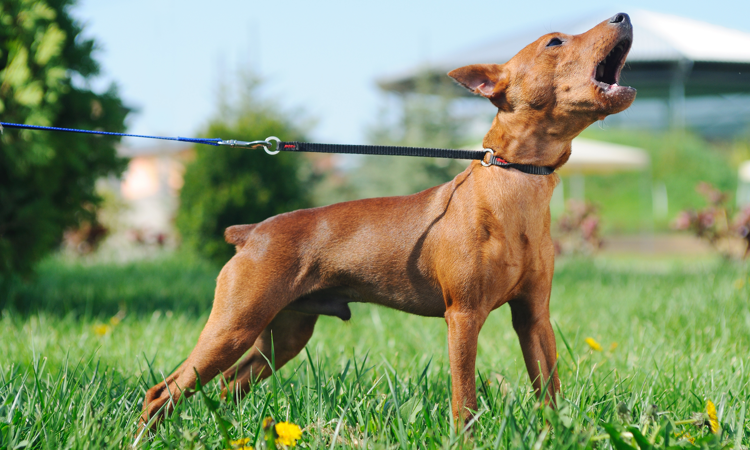
Territorial behaviour is one way for dogs to say “these toys, this food, this human – they’re mine, paws off!”. However, territorial behaviour can descend into aggression towards the person or dog they view as a threat. Territorial dogs show aggression towards unfamiliar people or animals around their property, whether that’s their food, toys – or favourite snoozing spot. If it’s someone they don’t know, those new sights, sounds and actions can make your dog feel anxious, defensive or alerted to what they see as a threat.
You’d be forgiven for thinking territorial aggression is an act of dominance, when in fact it’s usually a shining beacon of insecurity. Your dog’s negative behaviour is their way of controlling who is allowed near their property so they will survive and be safe. In your dog’s eyes your guests are unwanted trespassers who threaten the safety of your whole family.
However, territorial aggression isn’t restricted to the home. Your dog may feel compelled to protect you and your family regardless of where you are. Whether you’re visiting friends, at a park, or having coffee in a dog-friendly café, our canine companions can feel a compulsive urge to guard and protect the ones they love. The same can be said for claiming places and items outside the home. A dog may become aggressive and guard a park bench or a patch of grass they’ve declared theirs.
All territorial dogs want the same thing – for the person or animal to go away. So when that person does leave after your dog shows aggression, this reinforces your dog’s belief that barking or snapping gets what they want. That’s why territorial aggression is a very serious and slow burning process to correct. But there are steps you can take to manage your dog’s territorial aggression which we’ll cover further on.
What causes territorial aggression in dogs?
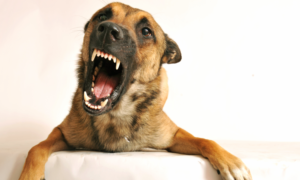
Your dog may aggressively defend the things they value because their actions have always achieved what they wanted in the past. This can then become a learned behaviour and their default response when guarding you, your home, toys or food. But there are a few other not-so-obvious causes and could be the reason why your dog is territorially aggressive.
- Poor puppy socialisation: If your dog was poorly socialised as a puppy they may not understand how to act appropriately around other dogs and people.Socialising your puppy at an early age gives your dog the life skills they need to feel confident and happy in our human world. By playing with other dogs they learn the secrets of doggy language that helps them get along with other canine friends.
- Bad experiences in your dog’s past: bad experiences can stay with a dog for many years. Many dogs who’ve been accepted into rescue and rehoming
- An underlying medical issue: could also be the cause of your dog’s aggression. If your dog is usually an affection pooch but has suddenly started lashing out, they could be in pain. Watch your dog’s body language and note any signs of discomfort. It’s best not to examine their body or feel for any signs of pain yourself, as your dog could snap. Book a vet appointment where they can examine your dog in safety.
- Changes in environment: Territorial aggression can also be brought on by the environment your dog lives in. If your garden has a fence running along a busy walkway, constantly hearing or seeing potential intruders can make your dog feel they need to patrol and protect their turf. Same can be said if they can see through a window looking on to a busy street.
- Your dog thinks they are the alpha: Dogs can be aggressive towards family members if they feel their alpha status has been challenged. Your pooch may be an affectionate family pet most of the time, but if your dog thinks someone has overstepped the mark, this can cause an aggressive response.
- Your dog’s breed: some dogs are naturally more difficult to train than others. Whilst it is true that some dogs are more independently minded, even stubborn if not trained properly, there’s no immediate evidence to suggest that certain breeds are more aggressive than others – read on for more details on this topic.
Are certain dog breeds more aggressive?
Opinion is split as to whether certain dog breeds are more aggressive than others. Large, guarding type dog breeds such as the Rottweiler or Doberman or other dog breeds who have historically been bred for fighting, such as Pitbull Terriers, are sometimes considered inherently aggressive. It could partly be down to the media that Pit Bull Terriers, in particular, have received a considerable amount of bad press over the years, although it is true that there have been several high profile cases of Pit Bull Terriers causing grievous injuries to people.
So much so, that the UK was the first country to place a ban on owning specific dog breeds, which includes Pit Bull Terrier, Japanese Tosas, Fila Brasileiro and Dogo Argentino. However, more than 25 years after the so-called Breed Specific Legislation was brought in, dog bites continue to be an issue and the RSPCA is one voice leading the charge in calling for the government to review the existing laws.
The RSPCA, among other dog welfare charities, says that the evidence does not point to any of the banned breeds as being more likely to cause harm to a person than any other dog. In fact, since the 1991 Dangerous Dogs Act, there have been 28 fatal dog bites which were not caused by restricted breeds or dog types.
Other factors, including breeding and the individual treatment and training of dogs, can cause a dog to become aggressive. In other words, a dog’s breed is not an indicator of how likely they are to behave aggressively, in fact, small so-called “cute and fluffy” dogs can become aggressive if not given the right training or socialisation, too.
What does territorial aggression look like?
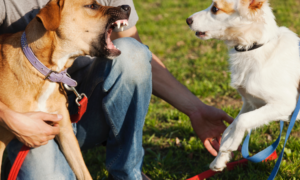
Territorial dogs can be a danger to your family, strangers and other animals. So it’s important you’re able to identify the behaviours your dog might display before they can cause anyone harm. As the owner of an aggressive dog, it’s your responsibility to ensure the safety of those around you. But by watching out for these signals you’ll be better prepared to seek help or use training to correct the problem.
Aggressive barking, snapping, lunging and biting are all clear signs your dog is trying to warn off potential invaders around their property. But your dog’s aggression can be fuelled by dominance or fear, with fear being the most common.
Here are a few of the behaviours you might see in a dominant dog with territorial aggression:
- Snarling
- Low-range excessive barking
- Standing tall
- Snapping
- Erect ears
- A high stiff tail moving side to side
- Staring
- More likely to attack or bite without giving a sign first
Here are a few of the behaviours you might see in a fearful dog with territorial aggression:
- Ears held back
- Avoiding eye contact
- Lowered body and head
- Tail tucked between legs
- Submissive urination
- May bite out of fear if touched
How to deal with territorial aggression in dogs
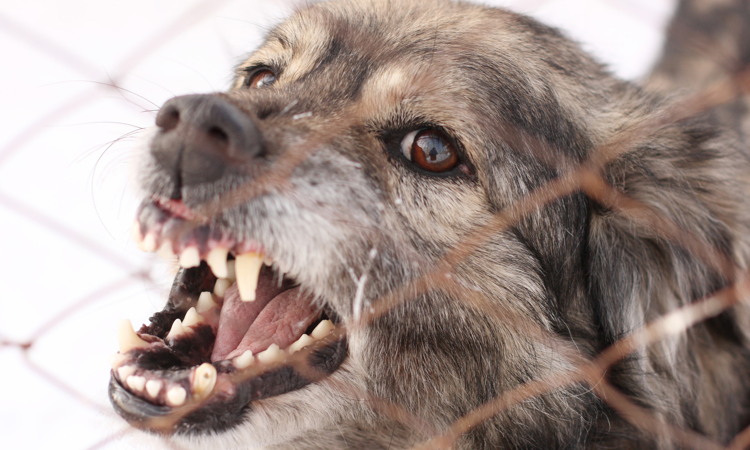
With territorial aggression, the problem is often a learned behaviour developed over time, so it’s important to be realistic with your expectations. A training program will help you control or manage your dog’s problem behaviour, rather than cure it. But that being said, there are a few effective methods that will help your dog cope and limit the number of aggressive incidents you see. All of which you can put to good use at home.
Should I seek help from a dog behaviourist?
If your dog has previously attacked another person or they’re excessively protecting their property, it may be time to seek help from a qualified dog behaviourist. A professional will have experience handling the same behaviour problems and will work with your dog to identify the trigger while building their confidence through positive training techniques.
The problem can become more severe when we accidentally reinforce the behaviours we don’t want to see. If your dog aggressively barks at other people while they’re sitting on your lap and you comfort them by stroking, your affection rewards them for the bad behaviour. Or perhaps as a puppy they growled when you tried to take a toy away so you gave in and let them have it. This can develop into more severe aggression later in life when people approach their toys or food.
How will the behaviourist help?
The trainer’s goal is to help you manage your dog’s emotions and how they react in stressful situations. They’ll help desensitize your dog to their triggers and give you management techniques to stop them from being able to practice the aggressive behaviour. They may offer a training plan to help your dog respond better to your commands, as well as teach impulse control to curb their reactivity. They will also help your dog accept others and relax while being around them, and share tips on keeping you and your guests safe in your home.
1. Identify the trigger
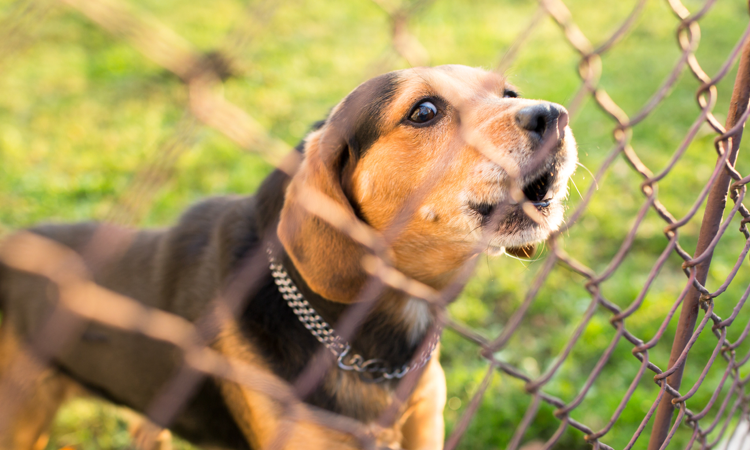
The first important step is to identify what it is that’s bothering your dog. Do they pace back and forth along the fences in your garden when hearing footsteps, or kick up a fuss when someone knocks on the door? Maybe they bare their teeth when you go near their bed, food or a toy. Finding out what sparks the reaction will help you pinpoint your training to deal with problem areas.
2. Reinforce training basics
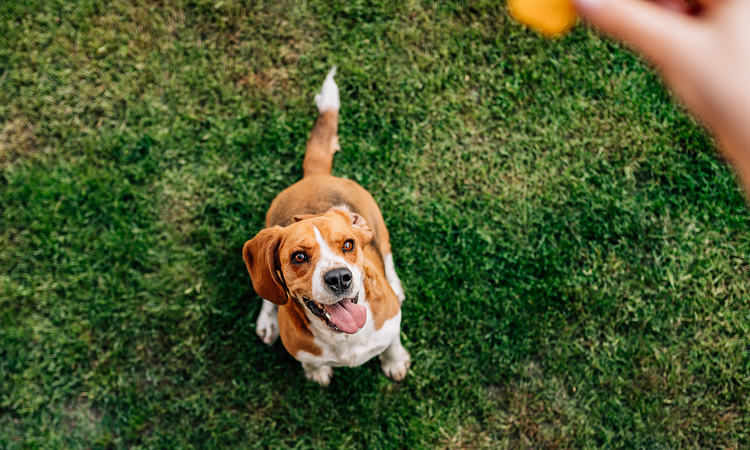
Training a reliable response to useful commands can prevent negative behaviours from occurring, or stop them from escalating. For example, if your dog will sit and stay without fail, you can tell them to do so in another room when someone knocks the door. This will keep your dog calm while giving you enough time to welcome guests into your home.
If your dog barks at others through the fence in your garden, teaching recall will ensure they come straight indoors when called. You may want to begin recall training inside where there are fewer distractions. Be sure to offer a tasty reward when they get it right and gradually move training to the garden.
Teach the “quiet” command if your dog tends to bark excessively when sensing a threat. If your dog likes to sit by a front window and bark all day long, teaching quiet will teach them to calm on cue. Begin training away from all triggers – move to a back room where your dog can’t hear noises or see passers-by.
Work on training your dog in 3-5 short training sessions everyday to strengthen their response to the commands.
3. Avoid using punishment
If you yell, startle or physically punish your dog when their trigger is around, they can build an association that the unfamiliar person or animal is indeed a threat. In the long term you may increase your dog’s fear and anxiety, but those important warning signs may decrease. That means you may, in fact, stop their barking and growling, but they could bite without warning. This can be extremely dangerous because people may think your dog is okay with them approaching, but your dog could strike out unpredictably. It is far more effective to teach your dog how you expect them to behave when others are near their territory.
4. Desensitize your dog to their triggers
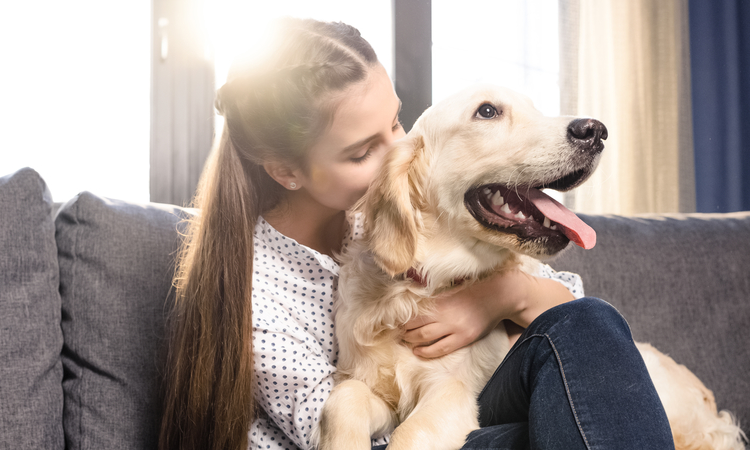
Desensitization and counterconditioning gradually changes the way your dog feels about the trigger. When you change your dog’s emotional state in problem situations you can also change their reactions. Go at your dog’s pace and never force the training if they’re clearly overwhelmed.
Here’s a quick example of what you can do if your dog reacts badly to visitors at the door. You may want to warn your visiting friend about your desensitizing training before they arrive! Get your dog’s attention and hold a tasty piece of chicken or cheese in your hand. Ask a friend to ring the doorbell and quickly offer the treat. Once your dog is more controllable and behaving the way you want, you can gradually increase the intensity by opening the door while they’re in a sit-stay. Let them see the person, close the door and offer a treat. Develop these small steps over time as your dog slowly builds their confidence and associates visitors with positive things.
5. Prevent aggressive displays
In the early stages as your dog is working on their training, you should take measures to break their habit loop by preventing access to triggers. For instance, close the curtains or use stick-on frost screening so they’re unable to see through problem windows.
When friends visit, keep your guests safe with a sturdy gate to restrain your dog in another room. In the garden, use a long line to give you more control when you need bring them back inside. Gradually, as your dog becomes more obedient and trusting as they learn to associate their original trigger with rewards, and no longer see them as a threat, you can withdraw these boundaries. They shouldn’t be used as a long-term solution and the goal should be to phase out using these methods gradually.
6. Manage your dog’s anxiety
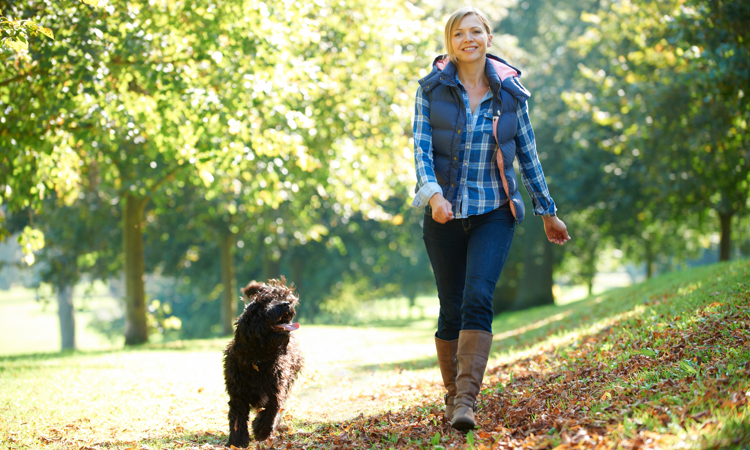
Your dog may be acting aggressively because they feel their turf is being threatened. Dog’s are natural pack animals – so they should naturally look to you, as their pack leader, to see what’s what. What’s more, your dog takes cues from body language, hand signals and tone of voice. Try to stay calm yourself, even if your dog is pulling on a lead and barking.
Help your dog feel calmer by wearing them out with mental and physical exercise. Your dog will be less likely to react if they’re occupied or too tired to put up a fight. If you’re having people around, keep your dog entertained with brain games and chews, or a simple Kong filled with peanut butter.
If your dog’s aggression is particularly severe, they may benefit from calming medication prescribed by your vet. But this should always be paired with the training we’ve mentioned above – medication alone won’t fix the problem. Some anxious dogs take great comfort from a thunder shirt. This gently wraps around your dog’s body providing security and calming qualities.
7. Use a ‘Nothing in Life for Free’ approach
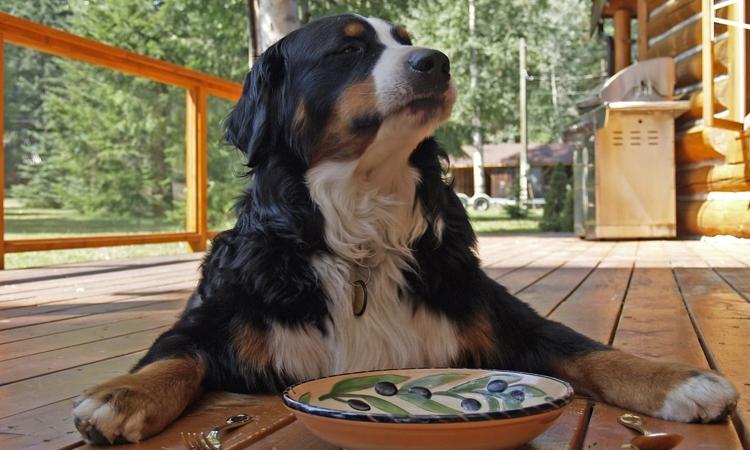
A learn to earn or Nothing in Life for Freeapproach follows the concept that your dog must earn all the things it wants in life– be that food, attention, toys or activities. The idea is that by controlling your dog’s rewards you can better control your dog in all circumstances and strengthen your overall relationship. So for every reward your dog wants, they must perform a task first.
For example, you could ask your dog to sit for a minute before getting their meal or lay down at the front door before leaving for a walk. You should only offer a life reward when they show you obedient behaviour first. This helps your dog understand what you expect from them and shows them you control all the good things they want.
Treating territorial aggression can be a gradual and often frustrating process. But with these tips, you’ll set a strong foundation for controlling and decreasing aggressive incidents at home. If you’re dealing with an aggressive dog and need a supportive shoulder, don’t hesitate to leave a message in the comments below or chat with us on Facebook and Twitter at @DogBuddyCo